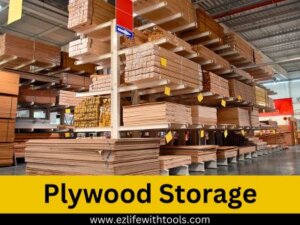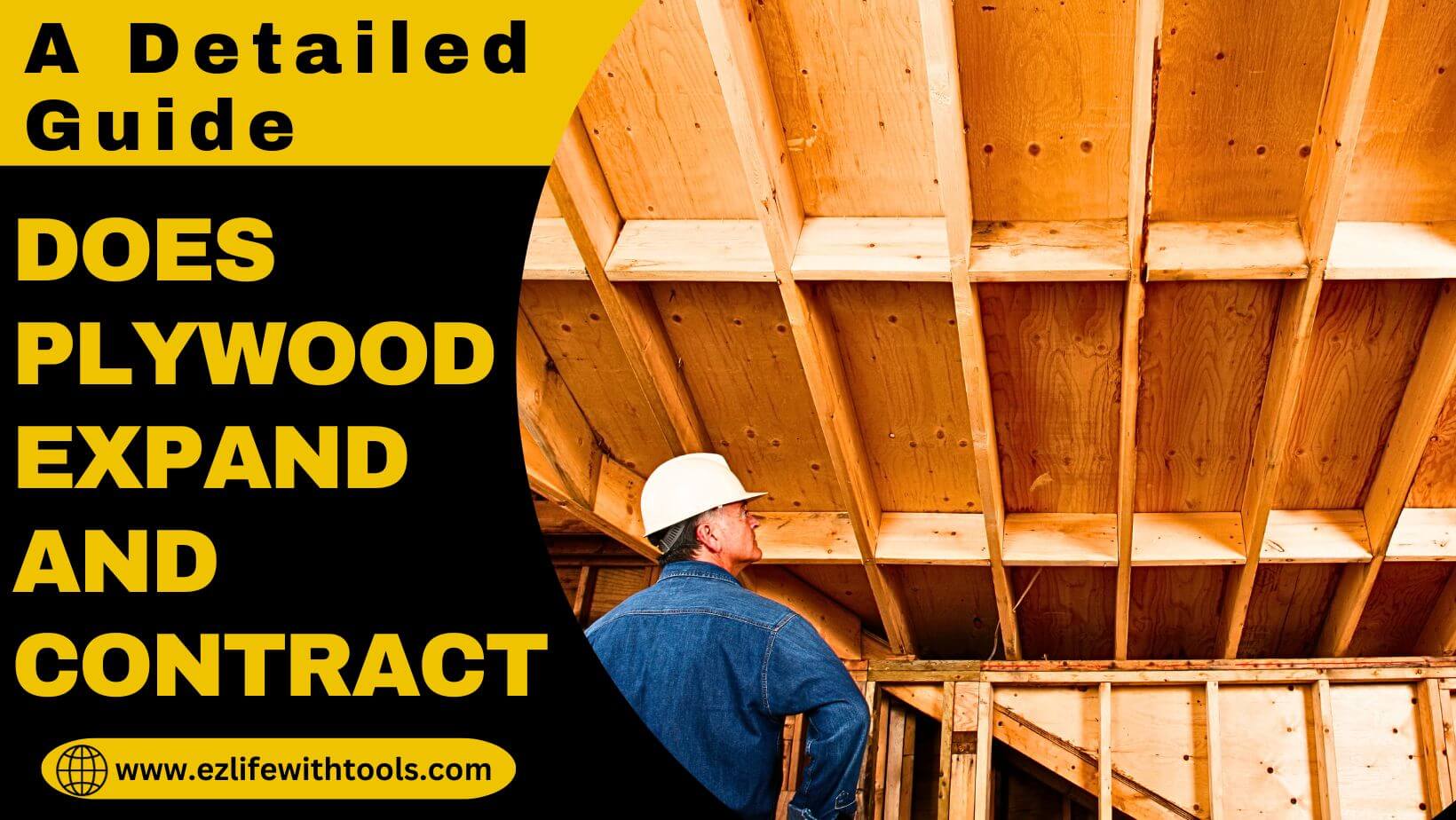Does Plywood Expand and Contract? The Unexpected Reality!
Plywood is a very popular and commonly used building material. It consists of 3-4 layers of wood veneer bonded together with special glue. It has become a basic need of every artisan and woodworker due to its strength, durability, and affordability.
However, like many other wood-based products, plywood has some queries about its immunity that should be solved first.
One of the questions always arises: Does plywood expand or contract?
The simple answer is “Yes”.
However, it is necessary to find all the reasons and solutions to minimize the effects of contraction and expansion.
So, today, in this article, I will explain all the reasons behind the plywood expansion and contraction and the solution that can minimize its effects on it.
So, keep reading.
Composition of Plywood
It is necessary to understand plywood composition first, before analyzing the factors that cause plywood expansion and contraction.
Plywood is made of various thin sheets of wood veneer. These sheets are created from different types of trees, and every tree wood has special characteristics.
All the veneer sheets are layered one by one and composite with special glue under specific pressure. Different trees wood can influence the plywood’s overall properties, regarding its environmental changes.
Note: I have already written a detailed article about How plywood is manufactured step-by-step. Read it also.
Understanding How Wood Behaves
When it comes to plywood, it’s all about how it reacts to moisture in its surroundings. If you’ve ever had a chance to work with wood, you probably know it’s a bit of a magician when it comes to absorbing and releasing water. When plywood gets wet, it tends to expand, while it shrinks when things get dry. It’s this natural playing of dimensions that can sometimes cause a bit of a drift in size, and trust me, getting a grip on this is key.
The basics are simple: wood sucks up moisture when the environment is humid, and lets go when it’s arid, making plywood a real champ in adapting to its environment. So, knowing this little trick can help you understand why your plywood might change shape throughout the year.
Factors Affecting Plywood Expansion and Contraction Behavior
Below are some factors that affect the plywood behavior.
Adhesive’s variations
The use of adhesive material in the bonding of the layers is one of the most significant factors in plywood expansion and contraction.
Different adhesive materials have different levels of moisture resistance, which can significantly impact the behavior of plywood expansion and contraction when exposed to a humid environment.
For example, an adhesive material that absorbs more humidity can cause the expansion of plywood, while low absorption adhesive material can cause contraction.
Moisture Content
It is a common thing. Where we live, moisture is always present in the atmosphere. And the moisture presence is the key factor for the dimensional changes in plywood.
By default, plywood absorbs and releases the moisture from its surroundings. When the humidity level increases in the winter, the plywood absorbs moisture and expands.
While in the summer season, plywood releases its moisture and contracts.
So, moisture is the key factor in the dimensional changes of plywood.
Temperature Variations
Temperature is another factor in the dimensional changes of any plywood.
It has reversible reaction effects on the plywood. Effects change with the changing of temperature.
Plywood expands with increasing temperature and contracts as temperatures drop.
This thermal response is essential to consider in the installation of plywood that is subject to temperature fluctuations.
However, this thermal effect also depends on plywood types, adhesive material, and veneer composition variation.
Grain’s Direction
Another critical factor is the grain direction of the individual wood veneer layers within plywood. Plywood is typically manufactured with alternating grain directions between layers, which helps minimize wood’s natural tendency to expand and contract along its grain.
When plywood expands or contracts, the opposing grain directions of the veneer layers can help stabilize the overall shape and reduce warping or twisting.
If the grain direction is the same in plywood manufacturing, it can cause expansion or contraction in the plywood.
Plywood Thickness
The thickness of plywood sheets can affect the value of expansion and contraction. Thicker plywood tends to be less responsive to environmental changes than thinner sheets.
Therefore, we should always choose the appropriate plywood thickness according to the required applications.
Read Also: How Much Plywood Do I Need for Any Project
Measuring How Much Plywood Expand and Contract
The amount of expansion in plywood really depends on a few key factors. As mentioned, changes in moisture content can cause the wood to expand or contract. From my experience, you can expect about 1/8 inch (3 mm) of movement for every 10% change in moisture. For a standard 4×8 sheet of plywood, this could potentially mean expanding or contracting by up to 1/2 inch (12 mm) in humid or dry conditions.
It’s always important to consider this natural movement when planning your projects, especially in areas with fluctuating moisture levels.
Generally, average rate of plywood expansion and contraction is around 0.1% to 1%.
Effects of Plywood Expansion and Contraction
Plywood is a common construction material that is susceptible to expansion and contraction due to changes in moisture content and other environmental conditions. From my experience, these natural movements can have real effects on plywood-based structures and furnishings.
For instance, I’ve seen how it can impact the structural integrity and even the aesthetic appeal of a project. Understanding these phenomena is crucial to ensuring the longevity and stability of your work. With the right planning, you can account for these implications and still make use of this versatile material in your projects.
Aesthetic Considerations
The visual appeal of plywood-based products like furnishings can be greatly affected by expansion and contraction. In my experience, warping, buckling, or even gaps caused by moisture variations can really detract from the intended aesthetics of a finished project. These imperfections often become more noticeable on exposed plywood edges or surfaces with clear finishes.
This is why designers and craftsmen need to consider the potential impact on the visual presentation of plywood elements. By employing suitable construction techniques, proper joinery methods, and the right finishes, you can mitigate these challenges, preserving the desired appearance of the final product.
Structural Implications
Plywood expansion and contraction can significantly impact the structural integrity of various projects. When plywood absorbs moisture, it might swell, leading to warping, buckling, or even delamination. On the flip side, in drier conditions, plywood can contract, causing gaps or cracks to appear. This constant fluctuation in size and shape can compromise the stability and load-bearing capacity of structural components, potentially posing serious safety hazards.
That’s why it is essential to understand plywood’s response to environmental changes when designing and constructing load-bearing elements. Making proper allowances for this movement can help to accommodate its potential changes and maintain the stability of the structure.
How to Minimize Plywood Expansion and Contraction
While there is no perfect method, but using these practical steps, we can minimize the effects of contraction and expansion.
Proper Plywood Storage

To minimize these effects, storing the plywood in a controlled environment is necessary. Remember, this environment should have stable humidity levels and moderate temperatures. Keeping plywood in a dry, well-ventilated area will help to maintain its stability, increasing its life and product value.
Sealants and Finishes
It is an effective way to control plywood expansion and contraction by applying sealing and finishing at the wood surfaces. Many quality finishes are available in the market, like paint, varnish, or polyurethane.
When we apply it on the plywood’s surface, it will work as a barrier to the moisture in the atmosphere. It can significantly reduce the extent of expansion and contraction, especially in outdoor exposure places.
Installation Techniques
In structural applications, proper installation is a technique that is very important to minimize the effects of plywood expansion and contraction.
For example, leave small gaps between plywood sheets to accommodate size changes.
Fasteners like screws and nails should be placed to allow for movement without causing splitting or cracking.
Engineers and builders are responsible for designing the structure to accommodate the allowance of expansion and contraction.
Adapting to Climate Changes
Understanding the specific climate conditions of your installation site is imperative when working with plywood. In my experience, adapting both the selection of plywood and the installation methods to the local temperature and humidity fluctuations can help mitigate expansion and contraction issues. This means choosing the right type of plywood and using methods that accommodate these changes to prevent problems down the road. By being mindful of the climate, you can effectively reduce the effects of movement in your projects.
Conclusion
Understanding the behaviors is crucial when using plywood in various applications. Because, it can affect the performance and life of our projects.
I have explained all the factors that can affect our projects, and described the solutions to minimize the contraction and expansion.
Following the described methods, you can effectively minimize the effects of plywood expansion and contraction to ensure the durability and stability of your structures and projects.
Thank you for your time.
Best Wishes
Frequently Asked Questions
Will plywood expand with heat?
Yes, Plywood will expand when any source of heat applied. Especially in summer plywood expansion and contraction rate fluctuate.
Does ply need an expansion gap?
Yes, plywood requires an expansion gap, especially where the wood is subject to changes in humidity and temperature. Expansion gap provide natural swelling and contraction ability to the plywood due to environmental conditions.
how much does plywood expand and contract?
Plywood expansion and contraction depends on various factors like type of plywood, available moisture and environment etc. Generally, average rate of plywood expansion and contraction is around 0.1% to 1%.

